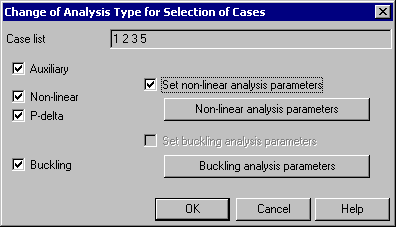Click Change analysis type in the Analysis Type dialog (the Case list field may not be left blank) to change the analysis type and parameters of the non-linear or buckling analysis.

Selection enables load case specific parameter modification.
Select Auxiliary case for a given load case to ignore it for calculations. No results will be available for the case. In linear-static analysis, results of a combination including such a case are unavailable. For non-linear analysis an auxiliary case may be useful when only the results of a case combination are of interest to the user. To reduce calculation time, calculations of a given case may be switched off, while a non-linear combination is always calculated as a separate case including a load combination.
Structure non-linearity can be related to a single structure element (structural or material non-linearity) or can be a result of the force-deformation relationship in the whole structure (geometric non-linearity). If a structure includes non-linear elements (such as cables, unilateral supports, and material plasticity), calculations applying the incremental method are performed.
Moreover, it is also possible to switch on geometric non-linearity.
- Non-linear analysis - takes account of the second-order effects, such as the change of bending rigidity depending on the longitudinal forces
- P-delta analysis - takes account of the third-order effects, such as the additional lateral rigidity and stresses resulting from deformation.
Selecting geometric non-linearity takes the actual higher-order effects into consideration and often improves the convergence of the calculation process for a structure including non-linear elements.
Buckling analysis determines the critical factor for successive modes of structure buckling. Thus, a factor is specified, by which the loads of a given case should be multiplied to obtain the buckling.
See also:
Bar elements in the non-linear analysis available in Robot